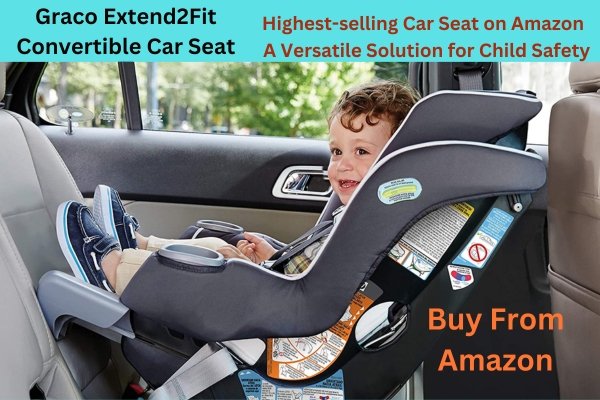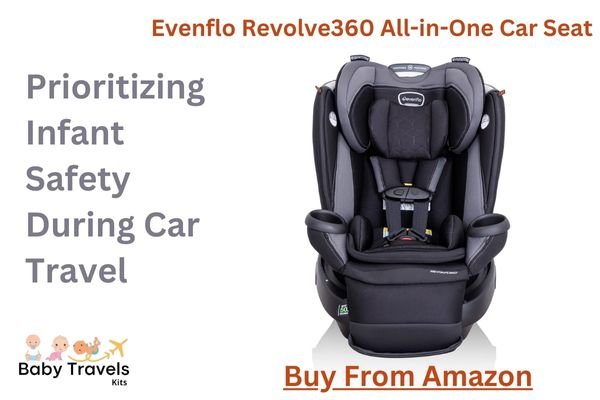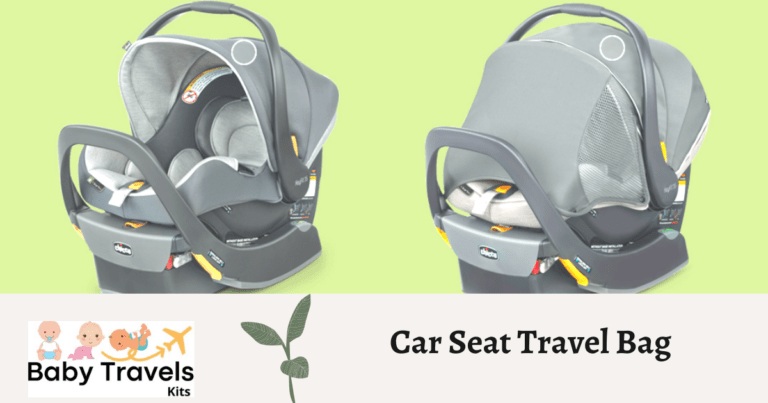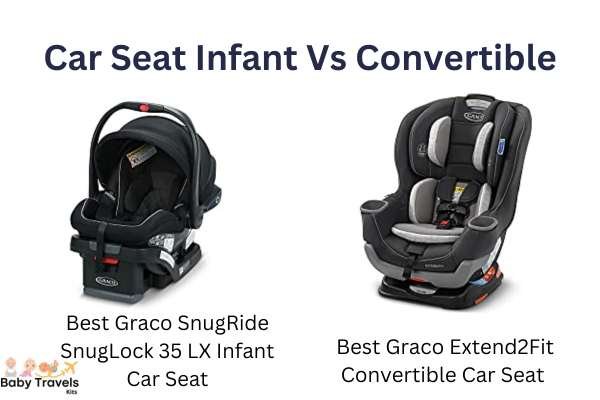Keeping infants safe is of utmost importance when traveling in vehicles. With the emergence of all-in-one car seats, a convenient and versatile option for parents, it becomes essential to address the central question: Are all in one car seats safe for infants? As parents, we strive to provide our little ones with the highest level of protection during car journeys.

Ensuring Infant Safety All-in-One Car Seats
Providing valuable insight to help parents make informed decisions and prioritize the safety of their children, this article focuses on the safety aspects associated with all-in-one car seats.
Infant Safety and the Importance of All-in-One Car Seats
Traveling in vehicles poses unique risks for infants due to their vulnerability. As a parent, you understand the need for a reliable car seat that ensures optimum protection. All-in-one car seats have gained popularity as they offer a convenient solution, accommodating the growth and changing needs of infants and toddlers.
However, it is crucial to examine their safety features and effectiveness to make an informed choice for your child’s well-being.
Exploring the Safety Aspects of All-in-One Car Seats
In this discussion, we will evaluate the safety considerations associated with all-in-one car seats. We will begin by examining the industry regulations and standards that govern car seat manufacturing, ensuring that all-in-one car seats meet rigorous safety requirements.
By adhering to these standards, manufacturers provide reassurance regarding the overall safety of these seats.

In addition, we will discuss the specific safety features of all-in-one car seats. These may include energy-absorbing foam, adjustable headrests, and five-point harness systems, among others.
Understanding these features will enable you to assess the protective capabilities of all-in-one car seats and make an informed decision based on your child’s individual needs.
Considerations for Infant Safety
While all-in-one car seats are designed to accommodate infants, it is crucial to consider certain factors to ensure their safety. Proper installation plays a pivotal role in maximizing the effectiveness of any car seat, including all-in-one options. We will explore the importance of following manufacturer guidelines meticulously and seeking professional assistance, if needed, to ensure correct installation.
Furthermore, we will discuss the significance of age, weight, and height recommendations provided by manufacturers. It is vital to select an all-in-one car seat that offers an appropriate fit for your infant, as this directly impacts their safety.
Additionally, we will touch upon the importance of monitoring the lifespan and condition of the car seat to ensure its ongoing safety and effectiveness.
The Best Graco Stroller Car Seat Combo For Your Little One
I. All-in-One Car Seats: A Versatile Solution for Child Safety
All-in-one car seats have emerged as a popular choice among parents seeking a comprehensive solution for their child’s safety during car travel. With their multifunctionality and versatility, these seats offer convenience and adaptability as children grow.
Comprehensive Definition and Multifunctionality
All-in-one car seats, as the name suggests, are designed to fulfill multiple stages of a child’s growth and development. They offer a seamless transition from infancy to toddlerhood and beyond, making them a long-term investment.
Unlike traditional car seats that are specific to one stage, all-in-one car seats are engineered to accommodate rear-facing for infants, and forward-facing for toddlers, and can even convert to booster seats for older children.
Key Features and Adaptability
One of the standout features of all-in-one car seats is their ability to adapt to the changing needs of a growing child. Starting with the rear-facing configuration, these seats provide crucial support for infants by cradling them in a position that helps mitigate the risks associated with crashes. As the child grows and reaches the recommended weight and height limits, the all-in-one car seat can be effortlessly adjusted to the forward-facing position, offering optimal safety and comfort for toddlers.
Furthermore, when the child outgrows the forward-facing configuration, all-in-one car seats can be converted into booster seats. Boosters provide the necessary height and support to ensure that the vehicle’s seat belt fits the child correctly, promoting a safe and secure travel experience. This adaptability makes all-in-one car seats an attractive choice for parents looking for a single investment that can last throughout their child’s early years.
Advantages of All-in-One Car Seats
Cost-effectiveness
Investing in an all-in-one car seat eliminates the need to purchase multiple seats as your child grows. While the initial cost may be higher compared to singular-stage seats, the long-term savings are significant. By choosing an all-in-one option, parents can potentially avoid the expense of purchasing separate infant, toddler, and booster seats.
Long-term Usability
All-in-one car seats are designed to grow with your child, offering extended usability. This not only saves money but also ensures that the seat remains a consistent and familiar space for your child, promoting a sense of security and comfort during car journeys.
Convenience and Portability
Unlike having to switch between different car seats as your child transitions through stages, all-in-one car seats provide a seamless solution. This convenience is especially valuable for busy parents who can benefit from the ease of use and simplicity that all-in-one car seats offer.
Safety and Peace of Mind
All-in-one car seats undergo rigorous testing and adhere to strict safety regulations, providing parents with peace of mind. Manufacturers design these seats with safety features such as energy-absorbing foam, adjustable harness systems, and side-impact protection to enhance child safety during potential accidents or collisions.
II. Safety Considerations for Infants
When it comes to the safety of infants during car travel, one of the most critical considerations is the use of rear-facing car seats. Infants are particularly vulnerable in the event of a crash, and providing them with extra protection is paramount.
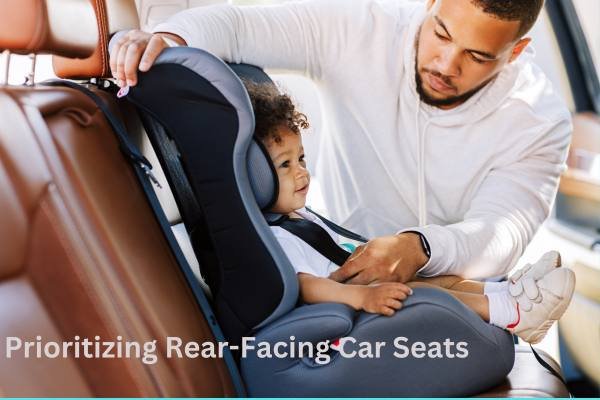
Understanding the Concept of Rear-Facing Position
The rear-facing position refers to the orientation of the car seat, where the infant faces the rear of the vehicle. This configuration ensures that the child’s head, neck, and spine are properly supported during sudden stops or collisions.
Infants’ bodies are still developing, and their heads are proportionately larger and heavier than the rest of their bodies. By placing them in a rear-facing car seat, the forces exerted in a crash are distributed more evenly across the child’s back, reducing the strain on their delicate neck and spine.
Mitigating Crash Risks for Infants
Rear-facing car seats play a crucial role in mitigating the risks associated with crashes, especially for infants. Due to their body proportions and muscle strength, infants are more susceptible to head and spinal injuries.
The rear-facing position helps protect their underdeveloped neck muscles and fragile bones by cradling their bodies and supporting their heads, preventing excessive movement during a collision. This significantly reduces the chances of severe injuries.
Statistics and Studies Highlighting Effectiveness
Numerous studies and statistics highlight the effectiveness of rear-facing car seats in safeguarding infants during car accidents. According to the American Academy of Pediatrics (AAP), infants should remain in a rear-facing car seat until they reach the maximum height or weight limit specified by the manufacturer, typically around the age of two. This recommendation is based on extensive research and analysis of crash data.
A study published in the journal Injury Prevention found that rear-facing car seats for infants under the age of two reduced the risk of injury by 93% compared to forward-facing seats.
Another study published in the journal Pediatrics analyzed crash data and concluded that children under the age of two were significantly safer in rear-facing car seats compared to forward-facing seats. These findings support the notion that rear-facing car seats provide superior protection for infants.
Furthermore, statistics from the National Highway Traffic Safety Administration (NHTSA) reveal that rear-facing car seats have been instrumental in reducing fatalities and injuries among infants involved in car accidents.
These seats have proven to be effective in preventing severe head and spinal injuries, which can have long-lasting consequences for a child’s development and overall well-being.
III. Evaluating the Safety of All-in-One Car Seats
When it comes to selecting a car seat for your child, safety is of paramount importance. All-in-one car seats offer convenience and versatility, but it is crucial to evaluate their safety features and standards.

Stringent Safety Standards and Regulations
Car seat manufacturers must adhere to stringent safety standards and regulations to ensure the highest level of protection for children. These standards outline specific criteria for design, materials, and performance. Rigorous testing and certification processes are carried out to ensure that all-in-one car seats meet or exceed these safety standards.
One recognized authority in car seat safety is the National Highway Traffic Safety Administration (NHTSA). Choosing all-in-one car seats approved by the NHTSA provides assurance that they have undergone rigorous testing and comply with federal safety regulations. The NHTSA evaluates various aspects, including crash tests, ease of use, and labeling requirements, to determine the overall safety performance of car seats.
Importance of Meeting Safety Standards
Selecting all-in-one car seats that meet or exceed safety standards is crucial for your child’s well-being. These standards are established to ensure consistent safety levels across different car seat models. By choosing a seat that complies with recognized safety standards, you can have confidence that it has undergone thorough testing and meets stringent safety requirements.
Safety Features of All-in-One Car Seats
All-in-one car seats incorporate various safety features to enhance protection for children. One common feature is energy-absorbing foam, which helps dissipate crash forces and reduce the impact on the child’s body. This foam is strategically placed in key areas of the seat to provide additional cushioning and protection.
Another important safety feature is the five-point harness system. This system secures the child in the seat by distributing crash forces across the strongest parts of their body, namely the shoulders, hips, and between the legs. Adjustable harness straps allow for a secure and comfortable fit as the child grows.
Adjustable headrests are also a notable safety feature of all-in-one car seats. They provide crucial support and protection for the child’s head and neck, helping to minimize the risk of injury during sudden stops or collisions. These headrests can be adjusted to accommodate the child’s height, ensuring a proper fit and optimal safety.
Durability and Stability Considerations
All-in-one car seats are designed to withstand various crash scenarios and maintain their protective functions. Durability is a key factor in ensuring long-term safety. Manufacturers subject these seats to rigorous testing to assess their ability to withstand impact and retain their structural integrity. It is important to choose a car seat that is well-constructed and made from high-quality materials to ensure durability and stability.
Additionally, proper installation and regular maintenance are essential for maintaining the safety and effectiveness of all-in-one car seats. Following the manufacturer’s guidelines for installation and maintenance, such as checking for wear and tear, will help ensure the seat’s ongoing safety.
IV. Buying Guide for All-in-One Car Seats
When selecting an all-in-one car seat for your child, there are several important factors to consider to ensure their safety and comfort. By taking these factors into account, you can make an informed decision and provide the best protection for your little one. Here are the key factors to consider:

Safety Features
Look for all-in-one car seats that prioritize safety with features such as a five-point harness system, side-impact protection, energy-absorbing foam, and adjustable headrests. These features contribute to enhanced protection and minimize the risk of injuries in the event of a crash.
Ease of Use
Consider the ease of installation and adjustment. Look for car seats that come with clear instructions and user-friendly features, such as easy-to-adjust harness straps and intuitive recline mechanisms. A user-friendly car seat will make your life easier and ensure that the seat is properly secured.
Fit and Comfort
Check the weight and height limits of the car seat to ensure it is suitable for your child’s size. It’s important that the seat provides a snug and secure fit without being too restrictive. Consider the padding and cushioning, as well as the ability to adjust the seat as your child grows. Comfortable seating can make long journeys more enjoyable for your child.
Durability and Longevity
Evaluate the durability and quality of the all-in-one car seat. Look for seats made from sturdy materials that can withstand the wear and tear of daily use. Additionally, consider the lifespan of the seat. Some models may have longer expiration dates, allowing you to use the seat for an extended period or for multiple children.
User Reviews and Recommendations
Read reviews and seek recommendations from other parents or trusted sources. Real-life experiences can provide valuable insights into the performance, reliability, and overall satisfaction of different all-in-one car seat models.
Budget Considerations
Set a budget range and look for all-in-one car seats that offer a balance between safety features, quality, and affordability. Remember, investing in a high-quality car seat is an investment in your child’s safety and well-being.
By considering these factors, you can make an informed decision when choosing an all-in-one car seat that meets your child’s safety needs and provides the necessary comfort for their journeys. Prioritizing safety, ease of use, fit and comfort, durability, user reviews, and your budget will help you find the best option for your little one.
V. Additional Safety Measures for Infant Travel
While all-in-one car seats provide essential protection for infants during travel, there are additional safety measures you can take to further enhance their well-being. By incorporating these measures into your routine, you can create a safer and more secure environment for your little one. Here are some important additional safety measures to consider:

Rear-View Mirrors
Installing a rear-view mirror specifically designed for monitoring infants can provide valuable visibility for your child while driving. These mirrors attach to the backseat headrest and allow you to glance at your baby without turning your head, reducing distractions and helping you keep a watchful eye on their well-being.
Anti-Rebound Bars
Anti-rebound bars are accessories that can be used with certain car seat models to enhance stability and minimize seat rotation in the event of a crash or sudden stop. These bars attach to the back of the car seat and help prevent excessive movement, offering an extra layer of protection for your child.
Regular Car Seat Inspections
Consistent and regular inspections of your all-in-one car seat are crucial to ensure proper installation and functioning. Check for any signs of wear and tear, such as frayed straps or loose parts. Verify that the seat is securely fastened and the harness is correctly adjusted. If you have any concerns or doubts, consult the manufacturer’s instructions or seek assistance from a certified car seat technician.
Secure and Distraction-Free Driving
Maintaining a secure and distraction-free driving environment is essential for the safety of your child. Avoid using mobile devices or engaging in activities that divert your attention from the road.
Secure loose items in the car that could become projectiles in the event of a sudden stop or collision. By focusing on the task of driving, you can reduce the risk of accidents and provide a safer experience for everyone in the vehicle, including your infant.
Conclusion
Prioritizing Infant Safety during Car Travel
Ensuring the safety of infants during car travel is of utmost importance. All-in-one car seats can provide a secure and protective environment for your little ones if certain factors are considered. By adhering to established safety standards, using the seats correctly, and ensuring a proper fit, all-in-one car seats can offer optimal protection for infants.
To make the best choice for your child, conduct thorough research and consult experts in the field of child safety. Consider factors such as safety features, ease of use, fit, and durability. Look for all-in-one car seats that meet recognized safety standards and have positive user reviews.
Remember, proper installation and usage are key to maximizing safety. Follow the manufacturer’s guidelines meticulously and consider seeking professional assistance for installation if needed. Regularly inspect the seat for any signs of wear and tear and adhere to expiration dates.
In conclusion, while all-in-one car seats can be safe for infants, it is crucial to make informed decisions and prioritize safety above all else. Your precious little ones deserve the highest level of protection during car travel. Invest the time and effort to select a reliable all-in-one car seat that meets safety standards, provides a proper fit, and ensures their well-being on the road.
Related:
Infant Car Seats (Car Seats Infant Vs Convertible)
Best Infant Car Seats
Convertible Car Seats (Car Seats Infant Vs Convertible)
Safety Features in All-in-One Car Seats: Ensuring Maximum Protection and Comfort for Your Child
When it comes to ensuring the safety of your child in a vehicle, nothing should be left to chance. Car accidents are an unfortunate reality, and the best way to protect your little one is by using an all-in-one car seat equipped with advanced safety features.
1. Five-Point Harness System: The Backbone of Safety
The Five-Point Harness System is the first line of defense when it comes to protecting your child in a car seat. This system secures your child at five critical points: over both shoulders, across the hips, and between the legs. Let’s take a closer look at why this feature is crucial:
Why It Matters
- Even Distribution of Force: The five-point harness evenly distributes the force of a crash across your child’s strong skeletal structure, minimizing the risk of injury.
- Prevents Ejection: It effectively prevents your child from being ejected from the car seat during a collision, which is a common concern with lesser harness systems.
- Restricts Movement: The snug fit restricts your child’s movement within the seat, reducing the chances of injury caused by excessive motion during a crash.
- Adaptable for Growth: Many all-in-one car seats come with adjustable harness heights to accommodate your child’s growth from infancy to toddlerhood.
Pro Tip: Ensure that the harness straps lie flat and snug against your child’s body without twists or slack to maximize their safety.
2. Anti-Rebound Bar Technology: Enhancing Stability
Modern all-in-one car seats often incorporate Anti-Rebound Bar (ARB) Technology to improve stability and safety. This feature reduces the seat’s movement in the event of a collision, especially during a rear-facing installation.
Key Benefits
- Minimizes Rotational Forces: In a rear-facing position, the ARB limits the seat’s rotation towards the back of the vehicle during a crash, reducing the risk of head and spinal injuries.
- Enhanced Safety: The added stability provided by the ARB ensures that your child remains securely in the seat, even during sudden stops or impacts.
- Optimal Comfort: The reduction in movement contributes to a smoother ride, enhancing your child’s comfort on long journeys.
- Compliance with Regulations: Many car seat manufacturers design their products with ARBs to meet stringent safety regulations.
3. Weight and Height Requirements: Customized Protection
Every all-in-one car seat comes with specific weight and height requirements set by the manufacturer. These requirements are not arbitrary; they are meticulously calculated to provide optimal safety and comfort for your child.
Why These Requirements Matter
- Proper Fit: Meeting these requirements ensures that your child fits securely in the seat, with the harness and other safety features working as intended.
- Crash Performance: The weight and height restrictions are determined based on extensive crash tests, ensuring that the car seat will perform effectively in real-world scenarios.
- Age-Appropriate: These guidelines help parents choose the right car seat for their child’s age, weight, and height, ensuring age-appropriate protection.
- Compliance with Regulations: Manufacturers adhere to strict regulations when setting these requirements, which ensures that the car seat meets safety standards.
4. Maximum Height for Improved Comfort: A Growing Child’s Needs
While safety is paramount, comfort is also essential for long car rides. Many all-in-one car seats have a maximum height limit for children. This limit is essential to provide your child with ample legroom and comfort as they grow.
Benefits of a Maximum Height Limit
- Legroom and Comfort: Children can sit comfortably with their legs in a natural position, reducing discomfort during extended trips.
- Less Restrictive: Taller children won’t feel cramped or confined, making car journeys more enjoyable for everyone.
- Reduced Fidgeting: With more legroom, children are less likely to fidget or become restless during rides, which can be distracting for the driver.
- Safety Continues: While the seat may have a maximum height for comfort, the safety features continue to protect your child.
5. Installation Guidelines Set by Manufacturer: The Final Piece of the Puzzle
Proper installation is paramount for the effectiveness of all safety features in an all-in-one car seat. Manufacturers provide detailed installation guidelines that should be followed diligently to ensure your child’s safety.
Why Following Manufacturer Guidelines Is Crucial
- Optimal Functionality: Proper installation ensures that all safety features, including the harness system and ARB, work as intended.
- Minimizes User Error: Following the manufacturer’s instructions reduces the risk of installation errors that could compromise your child’s safety.
- Legal Compliance: Failure to follow installation guidelines may void any warranties and could result in non-compliance with safety regulations.
- Peace of Mind: Knowing that you’ve installed the car seat correctly provides peace of mind during every journey.

